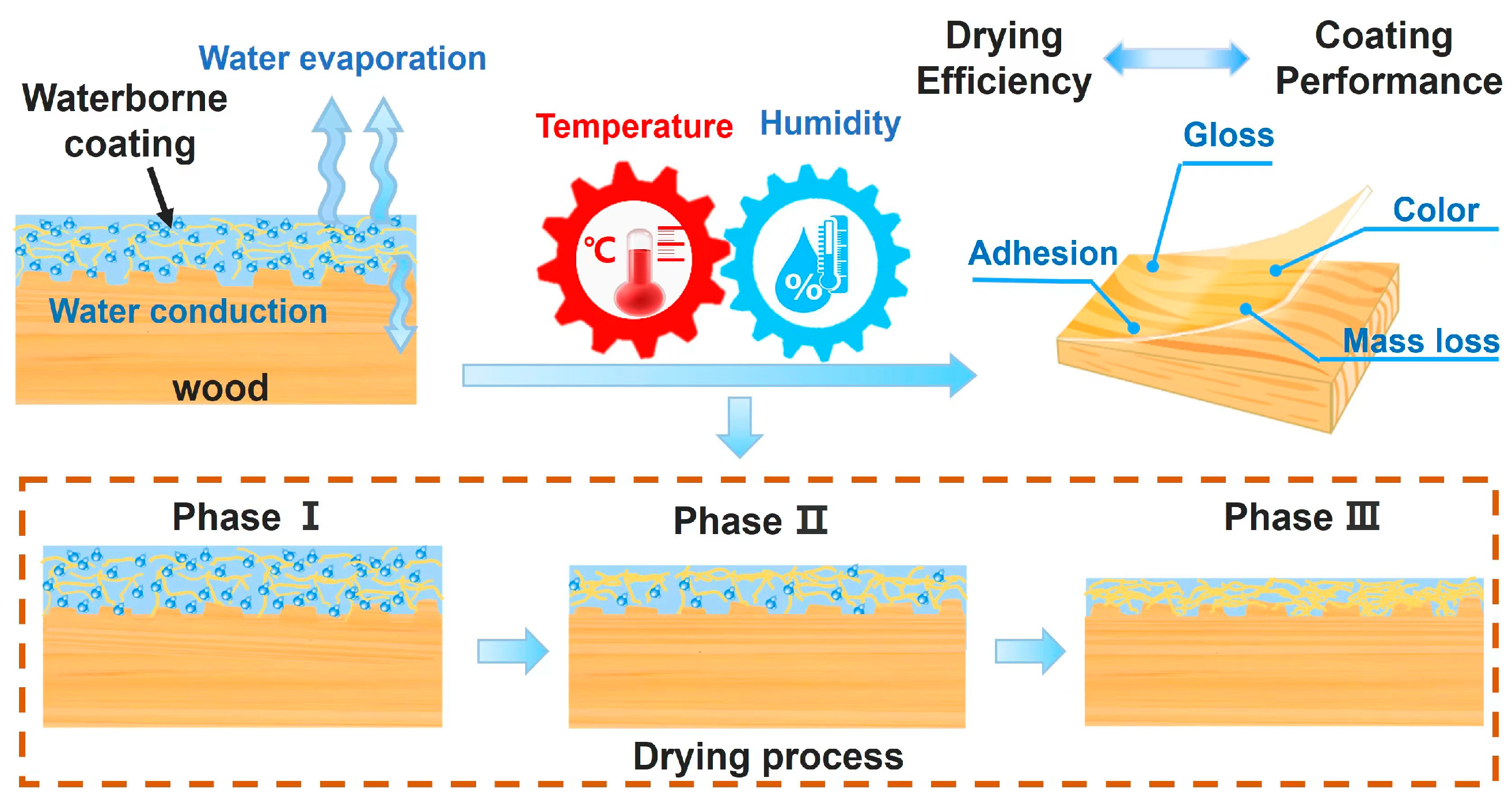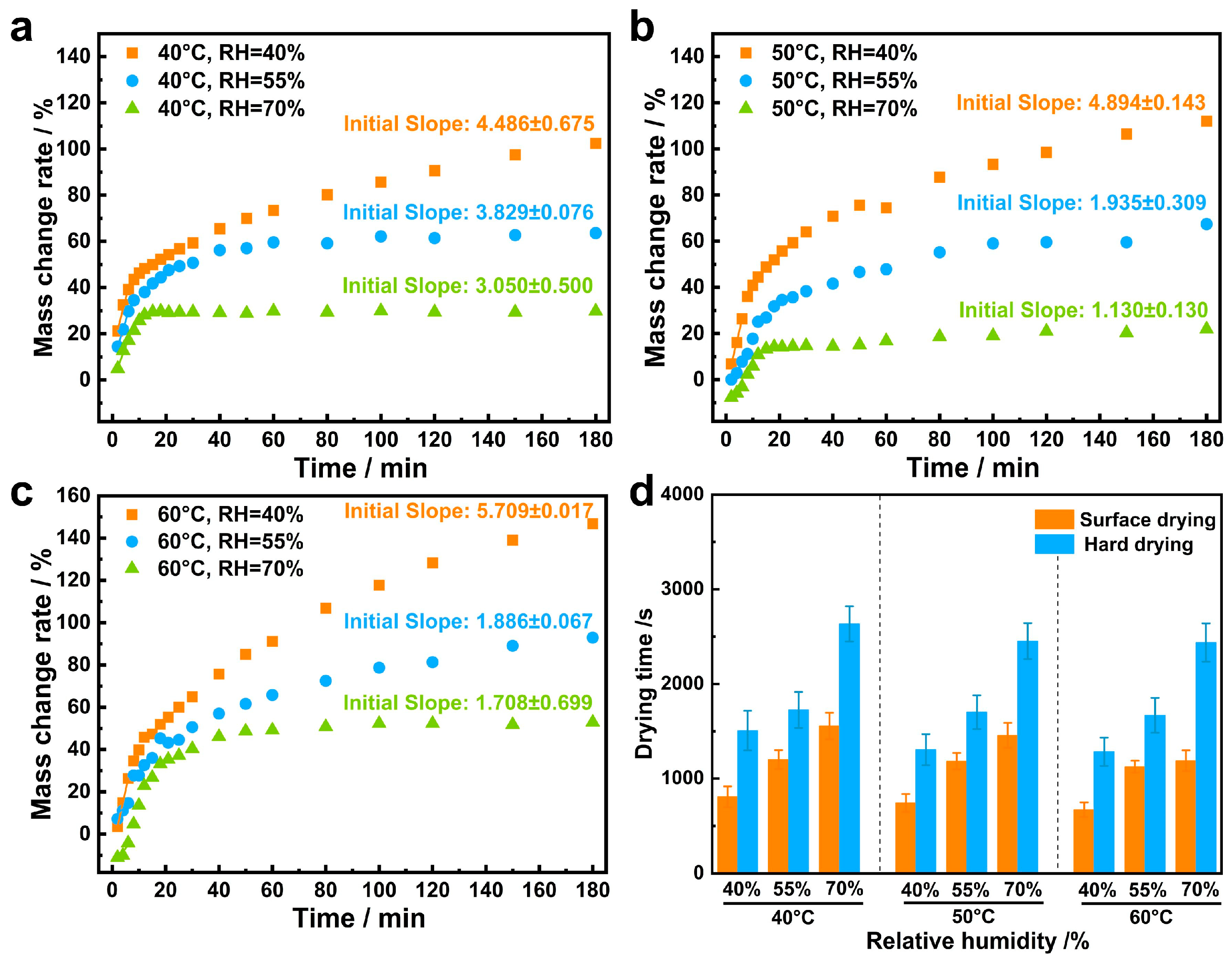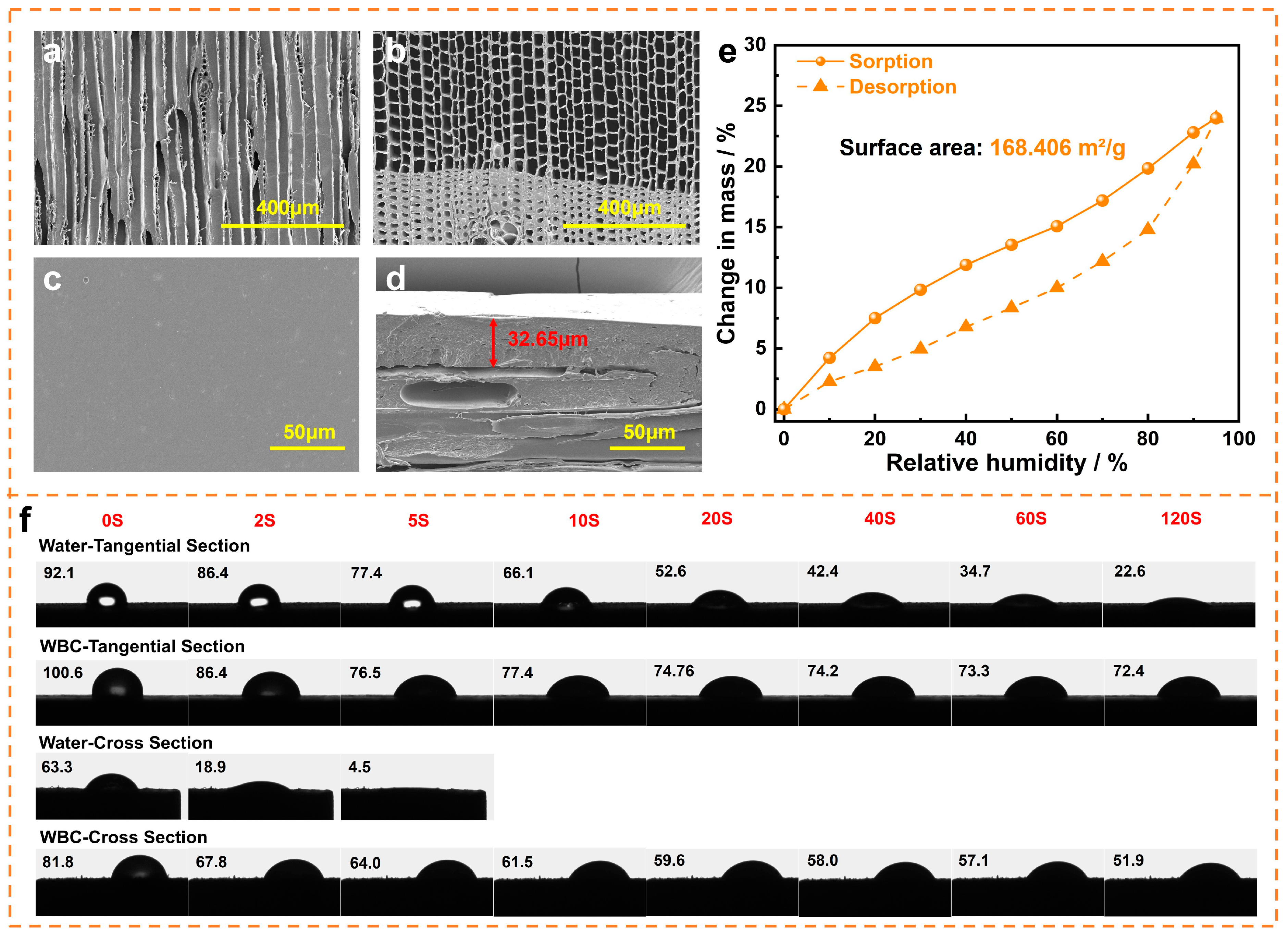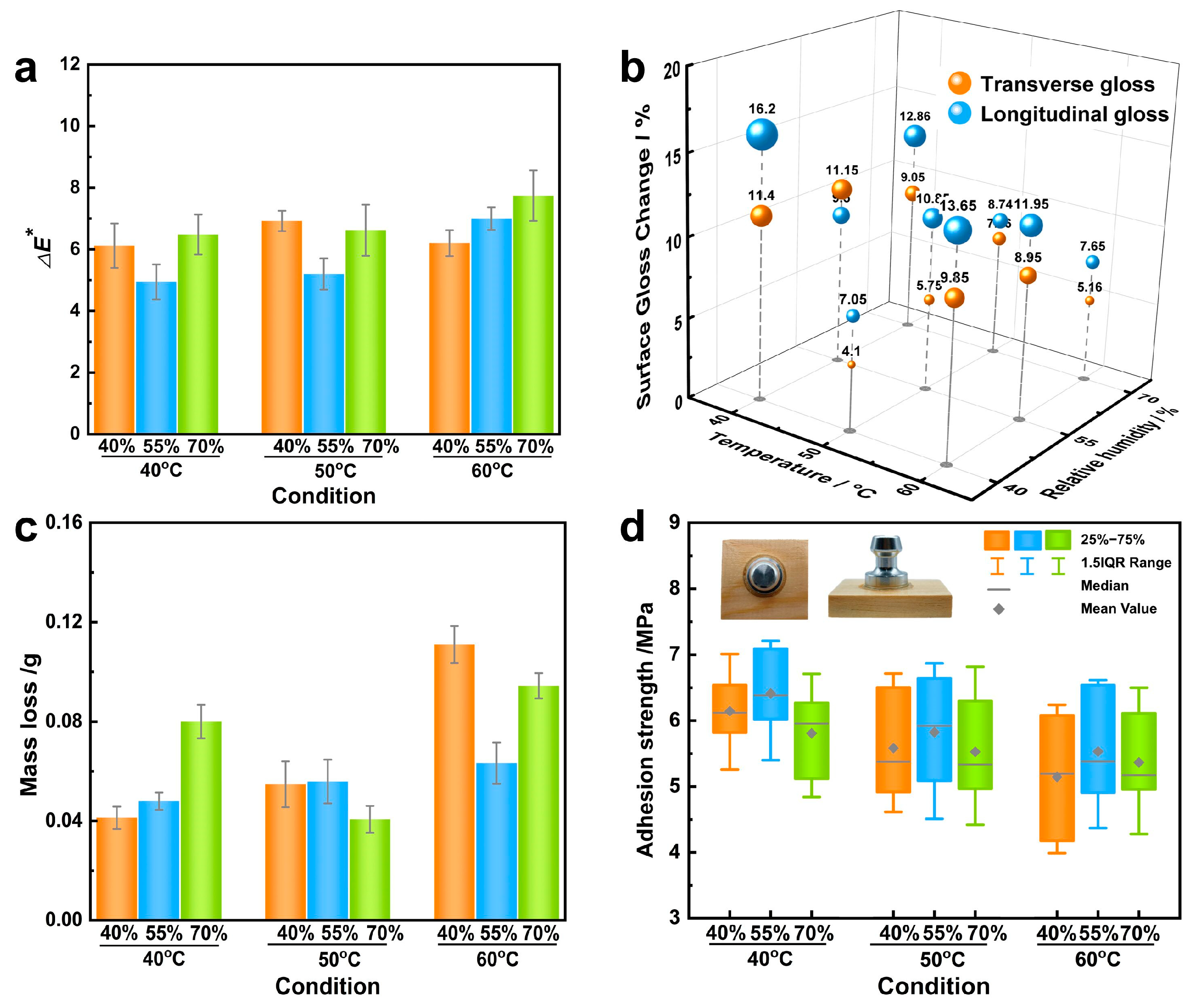Effect of Hot-Air Drying Conditions on the Drying Efficiency and Performance of a Waterborne Coating on Pine Wood
Abstract
:1. Introduction
2. Experimental Section
2.1. Materials
2.2. Hot Air Drying of WWC
2.3. Characterization
2.4. Statistical Analysis of the Data
3. Results and Discussion
3.1. Drying Rate of WWC-Coated Pine Wood during Hot Air Drying
3.2. Surface Drying and Hard-Drying Time Determination and Statistical Analysis
3.3. Structural Characteristics and Wettability of Pine Wood
3.4. Coating Performance of the WWC on Wood under Different Drying Conditions
3.5. Evaluation of Drying Efficiency and Coating Performance by Radar Analysis
4. Conclusions
Supplementary Materials
Author Contributions
Funding
Data Availability Statement
Acknowledgments
Conflicts of Interest
References
- Teischinger, A. Introduction to Wood Technology and Basic Processes. In Springer Handbooks; Niemz, P., Teischinger, A., Sandberg, D., Eds.; Springer International Publishing: Cham, Switzerland, 2023; pp. 571–593. [Google Scholar] [CrossRef]
- Jiang, F.; Li, T.; Li, Y.; Zhang, Y.; Gong, A.; Dai, J.; Hitz, E.; Luo, W.; Hu, L. Wood-Based Nanotechnologies toward Sustainability. Adv. Mater. 2018, 30, 1703453. [Google Scholar] [CrossRef] [PubMed]
- Zivic, F.; Grujovic, N.; Adamovic, D.; Divac, D. Development of new composites made of waste materials for wood pallet element. In Advances in Applications of Industrial Biomaterials; Pellicer, E., Nikolic, D., Sort, J., Baró, M., Zivic, F., Grujovic, N., Grujic, R., Pelemis, S., Eds.; Springer International Publishing: Cham, Switzerland, 2017; pp. 201–214. [Google Scholar] [CrossRef]
- Xiong, X.; Ma, Q.; Yuan, Y.; Wu, Z.; Zhang, M. Current situation and key manufacturing considerations of green furniture in China: A review. J. Clean. Prod. 2020, 267, 121957. [Google Scholar] [CrossRef]
- Asdrubali, F.; Ferracuti, B.; Lombardi, L.; Guattari, C.; Evangelisti, L.; Grazieschi, G. A review of structural, thermo-physical, acoustical, and environmental properties of wooden materials for building applications. Build. Environ. 2017, 114, 307–332. [Google Scholar] [CrossRef]
- Javadi, A.; Cobaj, A.; Soucek, M.D. Commercial waterborne coatings. In Handbook of Waterborne Coatings; Elsevier Inc.: St. Louis, MO, USA, 2020. [Google Scholar] [CrossRef]
- Noreen, A.; Zia, K.M.; Zuber, M.; Tabasum, S.; Saif, M.J. Recent trends in environmentally friendly water-borne polyurethane coatings: A review. Korean J. Chem. Eng. 2016, 33, 388–400. [Google Scholar] [CrossRef]
- Athawale, V.D.; Nimbalkar, R.V. Waterborne coatings based on renewable oil resources: An overview. J. Am. Oil Chem. Soc. 2011, 88, 159–185. [Google Scholar] [CrossRef]
- Hozjan, T.; Svensson, S. Theoretical analysis of moisture transport in wood as an open porous hygroscopic material. Holzforschung 2011, 65, 97–102. [Google Scholar] [CrossRef]
- Gutoff, E.B. The Drying of Waterborne Coatings. ACS Symp. Ser. 1997, 663, 245–264. [Google Scholar] [CrossRef]
- Imakoma, H. Drying characteristic model for water-based polymer coated film considering mass transfer acceleration by drying stress. Kagaku Kogaku Ronbunshu 2008, 34, 266–276. [Google Scholar] [CrossRef]
- Fu, J.; Wang, L.; Yu, H.; Haroon, M.; Haq, F.; Shi, W.; Wu, B.; Wang, L. Research progress of UV-curable polyurethane acrylate-based hardening coatings. Prog. Org. Coat. 2019, 131, 82–99. [Google Scholar] [CrossRef]
- Khudyakov, I.V. Fast photopolymerization of acrylate coatings: Achievements and problems. Prog. Org. Coat. 2018, 121, 151–159. [Google Scholar] [CrossRef]
- Noreen, A.; Zia, K.M.; Zuber, M.; Tabasum, S.; Zahoor, A.F. Bio-based polyurethane: An efficient and environment friendly coating systems: A review. Prog. Org. Coat. 2016, 91, 25–32. [Google Scholar] [CrossRef]
- Elrebii, M.; Ben Mabrouk, A.; Boufi, S. Synthesis and properties of hybrid alkyd-acrylic dispersions and their use in VOC-free waterborne coatings. Prog. Org. Coat. 2014, 77, 757–764. [Google Scholar] [CrossRef]
- Song, X.; Han, G.; Jiang, K.; Chi, X.; Liu, D.; Zhang, H.; Cheng, W.; Shi, S.Q. Effect of wood microstructure and hygroscopicity on the drying characteristics of waterborne wood coating. Wood Sci. Technol. 2022, 56, 743–758. [Google Scholar] [CrossRef]
- Tang, T.; Lu, Z.; Zhou, G.; Jia, W.; Wang, M. Effect of air velocity in dehumidification drying environment on one-component waterborne wood top coating drying process. Dry. Technol. 2016, 34, 1583–1592. [Google Scholar] [CrossRef]
- Lu, Z.; Tang, T.; Zhou, G.; Jia, W.; Wang, M.; Xu, J.; Bai, S. Effect of dehumidification drying environment on surface gloss of one component waterborne wood top coating. Appl. Therm. Eng. 2016, 102, 716–719. [Google Scholar] [CrossRef]
- Kamperidou, V.; Barboutis, I.; Vasileiou, V. Response of colour and hygroscopic properties of Scots pine wood to thermal treatment. J. For. Res. 2013, 24, 571–575. [Google Scholar] [CrossRef]
- Scrinzi, E.; Rossi, S.; Deflorian, F.; Zanella, C. Evaluation of aesthetic durability of waterborne polyurethane coatings applied on wood for interior applications. Prog. Org. Coat. 2011, 72, 81–87. [Google Scholar] [CrossRef]
- Lu, Z.; Tang, T.; Zhou, G.; Jia, W.; Wang, M.; Xu, J.; Bai, S. Effects of dehumidification drying environment on drying speed of one component waterborne wood top coating. Appl. Surf. Sci. 2016, 365, 131–135. [Google Scholar] [CrossRef]
- Sarkhad, M.; Ishiguri, F.; Nezu, I.; Tumenjargal, B.; Takahashi, Y.; Baasan, B.; Chultem, G.; Ohshima, J.; Yokota, S. Modeling of radial variations in wood properties and comparison of juvenile and mature wood of four common conifers in Mongolia. Holzforschung 2021, 76, 14–25. [Google Scholar] [CrossRef]
- Ding, T.; Zhang, Y.L.; Wang, N.W.; Jia, F.P. Comparative study on microstructure of Mongolian pine wood thermally treated in steam condition. In Proceedings of the 2012 International Conference on Biobase Material Science and Engineering, BMSE 2012, Changsha, China, 21–23 October 2012; pp. 254–257. [Google Scholar] [CrossRef]
- GB/T 1728–2020; Methods of Test for Drying Time of Coatings of Paints and Putties. Adm People’s Republic of China: Beijing, China, 2020.
- GB/T 4893.6–2013; Test of Surface Coatings of Furniture-Part 6: Determination of Gloss Value, Stand. Adm People’s Republic of China: Beijing, China, 2013.
- GB/T 4893.8–2013; Test of Surface Coatings of Furniture-Part 8: Determination of Wearability, Stand. Adm People’s Republic of China: Beijing, China, 2013.
- GB/T 5210–1985; Determination of Adhesion of Coats-Pull-Off Test, Stand. Adm People’s Republic of China: Beijing, China, 1985.
- Yamamoto, T.; Aizawa, E.; Imakoma, H.; Komoda, Y.; Ohmura, N. Drying Rate and Surface Optical Characteristic of Slurry Coating. Kagaku Kogaku Ronbunshu 2009, 35, 297–303. [Google Scholar] [CrossRef]
- Yamamoto, T.; Aizawa, E.; Imakoma, H.; Ohmura, N. Measurement of Drying Rate of Glue Coating by Modified Temperature Change Method. Kagaku Kogaku Ronbunshu 2009, 35, 246–251. [Google Scholar] [CrossRef]
- Zhao, D.; Pang, B.; Zhu, Y.; Cheng, W.; Cao, K.; Ye, D.; Si, C.; Xu, G.; Chen, C.; Yu, H. A Stiffness-Switchable, Biomimetic Smart Material Enabled by Supramolecular Reconfiguration. Adv. Mater. 2022, 34, 2107857. [Google Scholar] [CrossRef] [PubMed]
- Li, Y.; Yu, Y.; Lou, Y.; Zeng, S.; Sun, Y.; Liu, Y.; Yu, H. Hydrogen-Transfer Reductive Catalytic Fractionation of Lignocellulose: High Monomeric Yield with Switchable Selectivity. Angew. Chem. Int. Ed. 2023, 62, e202307116. [Google Scholar] [CrossRef]
- Liu, Y.; Deak, N.; Wang, Z.; Yu, H.; Hameleers, L.; Jurak, E.; Deuss, P.; Barta, K. Tunable and functional deep eutectic solvents for lignocellulose valorization. Nat. Commun. 2021, 12, 5424. [Google Scholar] [CrossRef]





| Temperature (°C) | Relative Humidity (%) | Surface Drying Time AVERAGE Value ± SD (%) and Significant Level | Hard-Drying Time Average Value ± SD (%) and Significant Level |
|---|---|---|---|
| 40 °C | 40% | 807.07 ± 50.63 c | 1506.19 ± 22.93 c |
| 55% | 1200.23 ± 64.07 b | 1725.66 ± 37.19 b | |
| 70% | 1555.15 ± 51.88 a | 2634.98 ± 52.44 a | |
| 50 °C | 40% | 742.14 ± 39.35 c | 1305.33 ± 31.91 c |
| 55% | 1183.26 ± 51.38 b | 1701.98 ± 70.86 b | |
| 70% | 1456.66 ± 54.05 a | 2452.71 ± 39.42 a | |
| 60 °C | 40% | 671.26 ± 46.05 b | 1284.08 ± 53.69 c |
| 55% | 1124.31 ± 49.72 a | 1668.95 ± 51.16 b | |
| 70% | 1187.95 ± 57.16 a | 2437.92 ± 31.46 a | |
| Temperature (°C) | ** | ** | |
| Relative humidity (%) | ** | ** | |
| Temperature (°C) × Relative humidity (%) | ** | ** | |
| Temperature (°C) | Relative Humidity (%) | ΔE* Average Value ± SD (%) and Significant Level | Transverse Gloss Average Value ± SD (%) and Significant Level | Longitudinal Gloss Average Value ± SD (%) and Significant Level | Mass Loss Average Value ± SD (%) and Significant Level | Adhesion Strength Average Value ± SD (%) and Significant Level |
|---|---|---|---|---|---|---|
| 40 °C | 40% | 6.1 ± 2.72 a | 11.4 ± 0.3 a | 18.2 ± 0.3 a | 0.041 ± 0.013 b | 6.4 ± 0.67 a |
| 55% | 4.9 ± 1.20 a | 11.1 ± 0.05 a | 9.5 ± 0.1 c | 0.04 ± 0.006 b | 6.1 ± 0.60 a | |
| 70% | 6.4 ± 0.95 a | 9.0 ± 0.15 b | 12.8 ± 0.92 b | 0.113 ± 0.039 a | 5.8 ± 0.70 a | |
| 50 °C | 40% | 6.9 ± 2.33 a | 4.1 ± 0.1 c | 7.0 ± 0.05 c | 0.054 ± 0.018 a | 5.8 ± 0.90 a |
| 55% | 5.2 ± 0.51 a | 5.7 ± 0.25 b | 10.8 ± 0.15 a | 0.055 ± 0.017 a | 5.5 ± 0.85 a | |
| 70% | 6.6 ± 0.83 a | 7.5 ± 0.05 a | 8.7 ± 0.12 b | 0.040 ± 0.034 a | 5.5 ± 0.89 a | |
| 60 °C | 40% | 6.2 ± 3.42 a | 9.8 ± 0.85 a | 13.6 ± 0.15 a | 0.111 ± 0.019 a | 5.5 ± 0.89 a |
| 55% | 7 ± 0.37 a | 8.9 ± 0.05 a | 11.9 ± 0.25 b | 0.063 ± 0.01 b | 5.3 ± 0.81 a | |
| 70% | 7.7 ± 2.52 a | 5.1 ± 0.05 b | 7.6 ± 0.12 c | 0.094 ± 0.02 ab | 5.1 ± 0.95 a | |
| Temperature (°C) | ** | ** | ** | * | ||
| Relative humidity (%) | ** | ** | ||||
| Temperature (°C) × Relative humidity (%) | ** | ** | ** | |||
Disclaimer/Publisher’s Note: The statements, opinions and data contained in all publications are solely those of the individual author(s) and contributor(s) and not of MDPI and/or the editor(s). MDPI and/or the editor(s) disclaim responsibility for any injury to people or property resulting from any ideas, methods, instructions or products referred to in the content. |
© 2023 by the authors. Licensee MDPI, Basel, Switzerland. This article is an open access article distributed under the terms and conditions of the Creative Commons Attribution (CC BY) license (https://creativecommons.org/licenses/by/4.0/).
Share and Cite
Song, X.; Wei, J.; Mao, Z.; Chi, X.; Zhu, Z.; Han, G.; Cheng, W. Effect of Hot-Air Drying Conditions on the Drying Efficiency and Performance of a Waterborne Coating on Pine Wood. Forests 2023, 14, 1752. https://doi.org/10.3390/f14091752
Song X, Wei J, Mao Z, Chi X, Zhu Z, Han G, Cheng W. Effect of Hot-Air Drying Conditions on the Drying Efficiency and Performance of a Waterborne Coating on Pine Wood. Forests. 2023; 14(9):1752. https://doi.org/10.3390/f14091752
Chicago/Turabian StyleSong, Xiaoxue, Jiajian Wei, Zhuyuan Mao, Xiang Chi, Zhipeng Zhu, Guangping Han, and Wanli Cheng. 2023. "Effect of Hot-Air Drying Conditions on the Drying Efficiency and Performance of a Waterborne Coating on Pine Wood" Forests 14, no. 9: 1752. https://doi.org/10.3390/f14091752
APA StyleSong, X., Wei, J., Mao, Z., Chi, X., Zhu, Z., Han, G., & Cheng, W. (2023). Effect of Hot-Air Drying Conditions on the Drying Efficiency and Performance of a Waterborne Coating on Pine Wood. Forests, 14(9), 1752. https://doi.org/10.3390/f14091752





